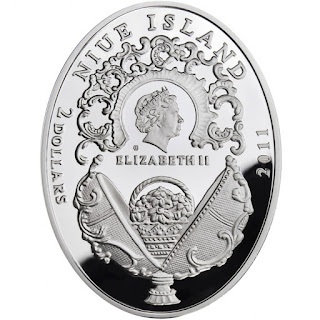Niue Island 2 Dollar Silver Coin 2011 The Duchess of Marlborough Egg - Faberge Egg
Series: Imperial Fabergé Eggs
Imperial Fabergé Eggs, known also as Tsar’s Fabergé Eggs, are considered masterpieces of the jeweller’s art and a symbol of extravagance and luxury. Created by Peter Carl Fabergé and his assistants for tsars: Alexander III and Nicholas II of Russia, the eggs were made of gold and silver and decorated with enamels and precious stones.
The Duchess of Marlborough Egg coin is the forth coin of the popular series “Imperial Fabergé Eggs”.
A low mintage, a unique design with elements in polished finish and zircons, make the coin highly attractive for collectors.
Obverse: At the bottom – open Spring Flowers Egg (1899-1903) with a miniature basket of wood anemones inside. Above – the Niue Island’s Coat of Arms with the inscription “ELIZABETH II” and the mint’s mark (m/w) below. Around the Queen’s effigy – a decorative neorococo scroll ornament. At the top – the issuer’s name: NIUE ISLAND. On the right – a nominal value of the coin (2 dollars), on the left – the year of issue 2011.
Reverse: At the top – a semicircular inscription: IMPERIAL FABERGÉ EGGS. In the centre – a stylized image of the upper part of The Duchess of Marlborough Egg with two pinkish-orange zircons imitating the colour of the original egg. The snake at the bottom part has a polished finish, as well as the pearls surrounding the egg, which emphasize the splendour of this piece of art.
Designer: Robert Kotowicz.
Country: Niue Island.
Year of Issue: 2010.
Metal: Silver.
Silver Fineness: Ag 925/1000.
Content: 1.82 Troy OZ.
Denomination: 2 NZD - legal tender in New Zealand.
Weight: 56.56 g.
Diameter: Ellipse 41.6 x 55.6 mm.
Quality: Proof.
Mintage: 7,000.
Exterior Decoration: Zircons and Elements in Polished Finish.
Producer: Mint of Poland (Mennica Polska).
Series: Imperial Fabergé Eggs
Cockerel Egg 1900 Faberge The Duchess of Marlborough Egg 1902 Faberge
The Duchess of Marlborough egg (also known as the Pink Serpent egg) is a jewelled enameled Easter egg made by Michael Perchin under the supervision of the Russian jeweller Peter Carl Fabergé in 1902.
The Duchess of Marlborough egg is the only large Fabergé egg to have been commissioned by an American, and is inspired by a Louis XVI clock with a revolving dial. It is similar to the earlier imperial Blue Serpent Clock egg.
History
The egg was made for Consuelo Vanderbilt, who became the Duchess of Marlborough when she married Charles Spencer-Churchill, 9th Duke of Marlborough in 1895.
In 1902 the Duchess and her husband travelled to Russia, where they dined with Nicholas II of Russia, and visited his mother, the Dowager Empress Maria Feodorovna at the Anichkov Palace. During this visit the Duchess would have almost certainly seen the Dowager Empress' large collection of Fabergé, which perhaps inspired her to order this egg.
The egg is believed to have cost over 5,000 rubles.
After her divorce from the Duke of Marlborough, Vanderbilt donated the Duchess of Marlborough egg to a charity auction in 1926. The egg was bought by Ganna Walska, the second wife of Harold Fowler McCormick, chairman of the International Harvester Company of Chicago. At the 1965 Parke-Bernet auction of her property, it was bought by Malcolm Forbes. It was the first of several Fabergé Easter eggs that Forbes purchased.
In 2004 it was sold as part of Forbes Collection to Viktor Vekselberg. Vekselberg purchased some nine Imperial eggs, as part of the collection, for almost $100 million. The egg is now housed in the Fabergé Museum in Saint Petersburg, Russia.



